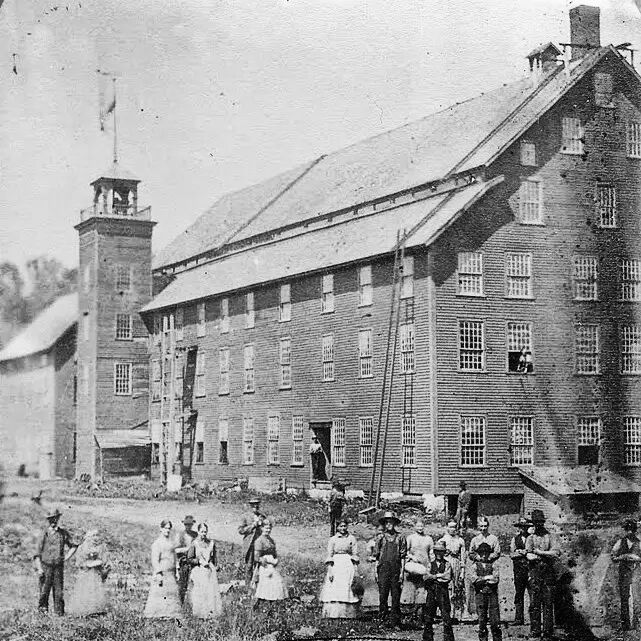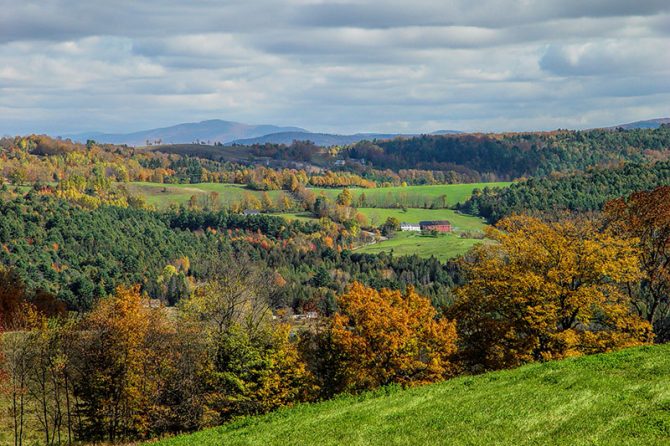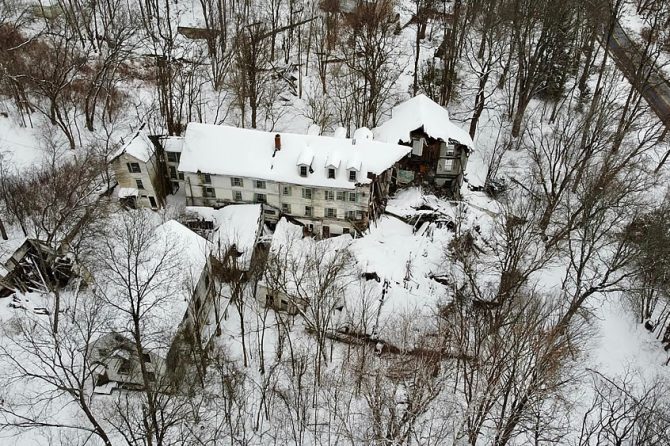(Photo above is courtesy of the Danville Vermont Historical Society)
Have you ever heard of Greenbank's Hollow? It was a buzzing mill village in Vermont that time forgot. Located within the lovely town of Danville it was once a hub for the wool and timber industries. This place, now a quiet shadow of what it was, played a huge role in New England's economy.
A Thriving Village Lost to Time
Nestled in the heart of Vermont's rolling hills lies the forgotten village of Greenbanks Hollow. Once a thriving community centered around the local gristmill, this quaint settlement has been slowly reclaimed by the surrounding nature.
Benjamin Greenbank was the key to this village's rich past. He built mills and homes that kept the economy going. Yet, in 1885, a tragic fire destroyed much of the village, leading to its end. But, there's a silver lining. The Danville Historical Society has preserved it as a historic park. This park has the village's covered bridge and hints of its past life.
The centerpiece of Greenbanks Hollow was Joe's Brook, a rushing waterway that powered the gristmill for generations. Locals would gather at the mill to have their grain ground, fostering a strong sense of community. However, as technology advanced and larger mills emerged, the Greenbanks Hollow gristmill fell into disrepair and was eventually abandoned.
Today, the remnants of the gristmill stand as a testament to the village's past. Visitors can wander the overgrown paths, imagining the bustling activity that once filled the area. Joe's Brook still flows steadily, a reminder of the natural resources that once sustained this forgotten community. They can see the efforts of Vermont's hardworking people long ago. It truly offers a unique peek into the history of Vermont’s busy industries.

History of Greenbank's Hollow
Greenbank's Hollow lies in the scenic town of Danville, Vermont, and has an interesting past. It became a major industrial area in the 1800s. This was thanks to Benjamin Greenbank. He helped the village thrive with New England mills and built a bustling industrial spot. and strong economy.
Benjamin Greenbank played a huge role in the area's growth. Under his guidance, Greenbank’s Hollow had the largest textile mill in New England. It attracted workers and boosted the economy. He also brought in a store and post office, making the village self-reliant.
The 1885 Fire: A Turning Point
On December 14, 1885, Greenbank's Hollow changed forever. Known as the 1885 Greenbank's Hollow fire, it reshaped the village completely.
Events Leading to the Fire
By 1849, Benjamin Greenbank had built a major woolen mill. By the 1850s, it employed 45 people. Throughout much of the 19th century, this significant woolen mill harnessed the brook's water power to manufacture cloth. In 1885, a fire destroyed the mill and the bridge over the brook, severing the village's connection to the rest of Danville.
Aftermath of the Fire
The fire left the village in ruins. The local school shut down in 1912 after businesses failed. Benjamin Greenbank moved his operations, which ended the village's economic importance. The Danville Historical Society has preserved the site, including the iconic covered bridge, as a park to remember its rich history.
Benjamin Greenbank and his Legacy
Benjamin Greenbank was crucial in developing Greenbank's Hollow's industrial scene. He left a lasting mark. After a huge fire in 1885, he chose to rebuild in Enfield, New Hampshire. This move has deeply affected history.
Contributions to the Village
In 1849, Benjamin Greenbank bought a mill. He turned it into a large woolen mill, hiring 45 people by the 1850s. It became the biggest in the area. This move helped the local economy and made Greenbank's Hollow an industrial center. It led to more businesses in the village, boosting prosperity and growth.
Relocation to Enfield, New Hampshire
The 1885 fire was a major event for Greenbank's Hollow. After, Benjamin Greenbank decided to move his business to Enfield, New Hampshire. His choice helped his industrial legacy live on, even as the hollow's businesses and school closed by 1912. Greenbank's actions greatly impacted both Enfield's development and the history of both places.
The Five-Story Woolen Mill
Greenbank's Hollow in Danville, Vermont, had its heart at a huge five-story woolen mill. This mill greatly influenced the village's economy and identity.
Construction and Operation
In 1849, Benjamin Greenbank turned the mill into a big five-story woolen mill. This move boosted the economy, making the village a lively place. It was the largest mill around in the 1850s, which was quite impressive. The village also had a post office, a store, and a school. There was a gristmill and a sawmill too. All these places helped the people of Greenbank's Hollow live well together in a strong community.
Production and Employment
At its best in the 1850s, the woolen mill had 45 workers. It played a key role in the local economy, being a major employer. They made a lot of woolen cloth, which was important for the industry. The mill did more than give people jobs; it made the community stronger. It supported many families and brought them together. But, this good time ended when a fire in 1885 destroyed the mill, changing Greenbank's Hollow's path forever.
Greenbank's Hollow Covered Bridge

The Greenbank's Hollow Covered Bridge is a historical gem in Danville, Vermont. It was built in 1886, after fire destroyed the original one in 1885. It played a key role in transport and added beauty to the scenic byway.
Original Construction
This covered bridge was crucial for local travel and stood as a symbol of recovery. Made with classic wooden truss design, it looked good and worked well. In 1970, steel beams were added to keep it strong.
Restoration Efforts
Danville worked hard to fix the bridge, with help from a $300,000 grant from the U.S. Department of Transportation. This money was a big part of fixing the bridge and keeping its history alive. The Vermont Agency of Transportation and Hoyle, Tanner Associates helped with the project.
There were several ideas for saving the bridge. VTrans helped decide by planning meetings and using the land correctly. Now, the bridge is a proud piece of Danville's history thanks to everyone's hard work.
Today, when folks drive through the scenic byway, the bridge reminds them of its past. It shows how important it was to Greenbank's Hollow's people.
The Role of Joe's Brook
In the heart of Greenbank's Hollow, Vermont, Joe's Brook is key. It powered mills that boosted the economy. Now, it attracts occasional visitors with its beauty and Northeast Kingdom charm.
Providing Water Power
Joe's Brook was vital for running the mills. Its steady flow made textile production possible, aiding village wealth. The brook's natural and man-made features made this possible. Joe’s Brook flows through a rugged hilly ridge and drops over steep, rocky falls into West Danville
Scenic Views and Hiking Trails
Today, Joe's Brook is known for its beauty and history. Its waters flow through stunning landscapes. Hiking trails let people enjoy the views and link to the past.
Trails by Joe's Brook suit just about everyone. Beginners and avid hikers can enjoy different routes. Along these paths, they'll see clear waters, colorful trees, and sometimes wildlife. It shows the brook's value to locals and visitors in Danville, Vermont.

Preservation Efforts by the Danville Historical Society
The Danville Historical Society has been crucial in saving Greenbank's Hollow, a key part of Vermont history. After a big fire in 1885 destroyed much of the village, the society aimed to restore the historic site. This effort included fixing the covered bridge that was lost in the fire.
A major task was to save the Greenbanks Hollow Covered Bridge. Built in 1886, after the fire, the bridge needed lots of work by 1970. Then, in 2002, they began more repairs, helped by the National Covered Bridge Preservation Act. This act paid for most of the work, like fixing the trusses and roof. They also got a big help – a $300,000 grant from the U.S. Department of Transportation.
But their work didn't stop with the bridge. In 2004, thanks to land donations, they constructed a historical park. The Danville Historical Society turned it into a spot for learning and fun. They had a lot of help from volunteers, who did things like build a kiosk and take care of the park.
Many local people and groups supported their efforts. The Danville Chamber of Commerce and the Town of Danville gave money. Mary Prior and Margaret Springer helped plan the whole thing, and the Danville Board of Selectmen made it official by accepting the park.
To mark these great achievements, the society held a special event on December 11, 2011. It was at Greenbank's Historical Park, where people from the community came together. They remembered the village's past and celebrated its history. Thanks to everyone's hard work, Greenbank's Hollow's story will always be remembered.

Significance of Hollow Villages in Vermont
Hollow villages like Greenbank's Hollow are key to Vermont's history. They were once rural centers, full of life and tradition. They played a big part in the 18th and 19th centuries, boosting the local economy. These hollow villages show us what life was like in New England back then. The mix of industry and community shaped Vermont's look and feel.
These places are not just historical. They also add beauty and culture to Vermont. Efforts to save sites like Greenbank's Hollow show we value our past. Danville's ongoing plans aim to keep focusing on these communities' past and future.
Vermont's hollow villages symbolize the strength of its rural areas. They honor the past while embracing the future. These villages keep Vermont's heritage alive for new generations.
Visiting the Historic Site Today
Going to historic site visit Greenbank's Hollow is a special way to learn about Vermont's past. This peaceful historical park used to buzz with activity. It now invites you to uncover the tales and relics it holds.
The Greenbank's Hollow Covered Bridge, a well known Danville attraction, shows how much Vermonters care about saving history. Built in 1886 and fixed up thanks to funding, this bridge draws visitors who are interested in the past.
The precise date of the bridge's construction and the identity of its builder remain unknown. Vermont historian Herbert Congdon suggests that the bridge was initially built without a roof, which was added at a later time. The bridge shares stylistic elements with those in nearby Lyndon, characterized by queen post trusses, half-height siding, and wide roofs. It stands as the sole remaining covered bridge from the 19th century in the town of Danville.
While Greenbanks Hollow may have faded from the public eye, its story serves as a poignant example of the resilience of Vermont's rural heritage. Those who venture to this enchanting location can't help but be captivated by the quiet beauty and the echoes of a bygone era.
Exploring Nearby Attractions in the Danville, Vermont area
Greenbank's Hollow is just the start in Danville. There's lots more to see and do. The area is full of beautiful sights and history. You'll find many places that show why New England is special.
This Northeast Kingdom town is perfect for those who love exploring. Danville is known for fun events like the Danville Fair, which brings people from all over. With the Danville Farmers' Market and the Great Vermont Corn Maze, there's always something new to see. If you're into the outdoors, you'll love Joe's Pond. It's great for powerboating, fishing, swimming, and sailing. The 93-mile Lamoille Valley Rail Trail is also nearby. It's ideal for biking, walking, horseback riding, and winter sports. The neighboring town of Peacham is nearby and is also a must-see destination.
After a fun day, there's plenty to do in Danville. You can chill at the Red Barn Brewery or play mini-golf at Sugar Ridge RV Village and Campground. Reflecting on your day at Greenbank's Hollow ties the whole experience together.
Nearby Peacham's Scenic Viewpoints
Peacham is famous for its stunning mountain and valley views. Its landscapes are among Vermont's most photographed spots. Nature lovers and photographers will find it ideal. Movie lovers will be excited to see some familiar sites such as the historic general store that was featured in movies such as Ethan Frome and the Spitfire Grill.
Other Area Attractions
Danville has many things to do and see. There are exciting events that celebrate history and culture too:
- The Autumn on the Green craft fair brings together more than 200 crafters. For over a decade, Autumn on the Green has been bringing crafters, artisans, antiques and food to the center of beautiful Danville, Vermont. Always on the first Sunday in October!
- The Danville Farmers’ Market is open from June to October. It offers fresh things to eat and crafts every Wednesday from 9 AM to 1 PM.
- The Great Vermont Corn Maze is one of the biggest in New England. Hundreds visit each year for a fun and challenging experience.
- Joe’s Pond in West Danville is perfect for boating, fishing, swimming, and sailing. Its 393 acres make it great for water activities.
If you like relaxing activities, Sugar Ridge RV Village & Camp campground is a good place. It has a mini-golf course, wagon rides, and an ice cream shack. The Red Barn Brewery on Route 2 East is known for its unique beers. They also have live music and food trucks from Wednesday to Sunday.
These local spots help you enjoy Vermont's culture. They also make learning about Danville's history fun and exciting.
Conclusion
The story of Greenbank's Hollow is a glimpse into Vermont's rich past. It tells how industry, disaster, and resilience shaped a community. Visitors stepping into the site travel back in time. They feel the spirit of hard work that filled this old mill village. Thanks to the Danville Historical Society, this place remains a witness to history and educates the young.
Benjamin Greenbank changed a simple building into a big woolen mill in the 1850s. This made the village important industrially. But in 1885, a fire severely damaged everything, leading to the village's decline. Despite this, efforts to keep Greenbank's Hollow's story alive continue. Now, as a park, it lets us and others think about the village's role in Vermont’s past.
Visiting Greenbank's Hollow is not just a trip. It's about connecting with Danville's lasting impact. The carefully kept bridge, the mill, and Joe's Brook tell stories of the past. They show the community's strong heritage. This site is a tribute to historical understanding. It invites everyone to value and remember its important story.
Thank you for visiting Vermonter.com! Please subscribe to our email list for the latest articles!




